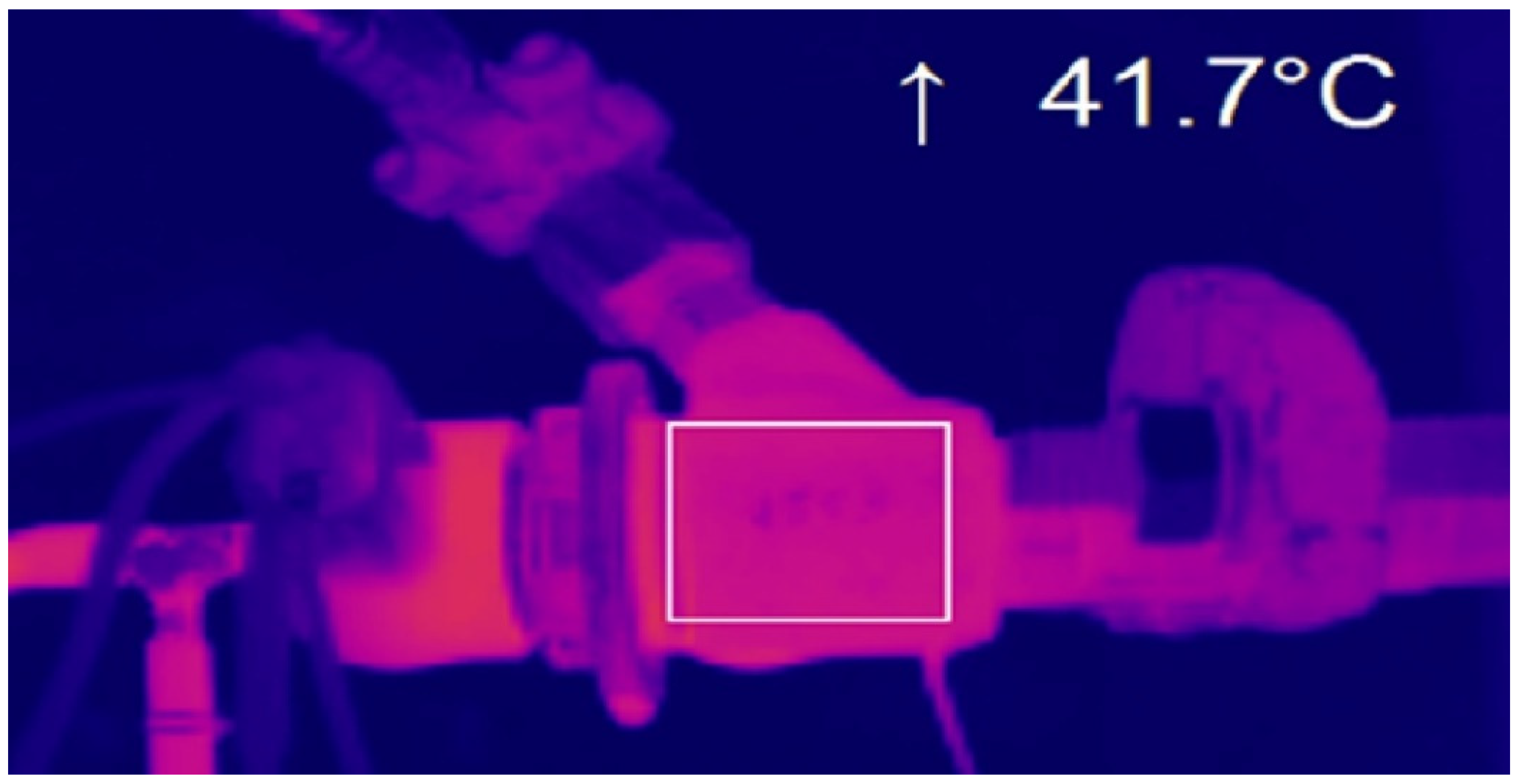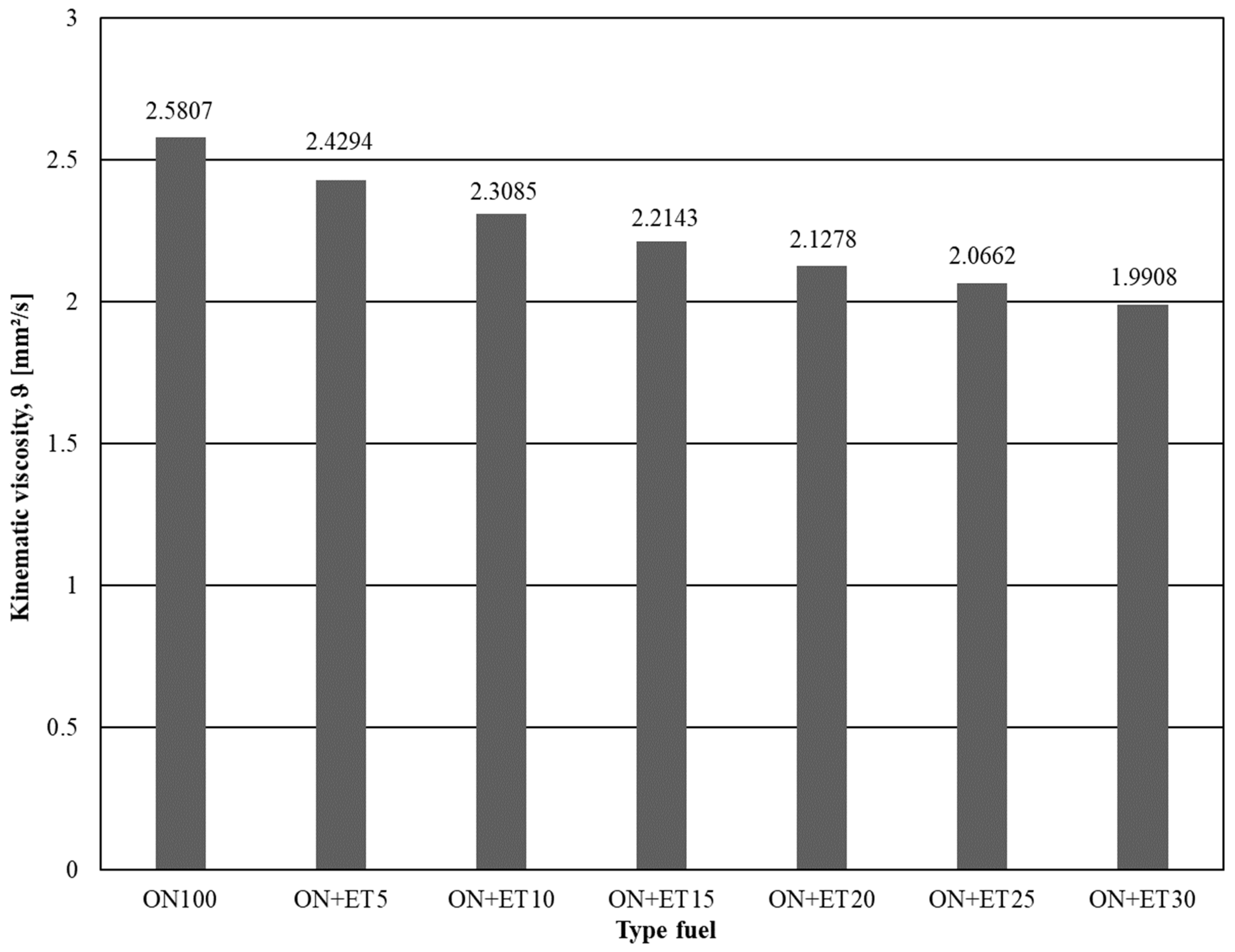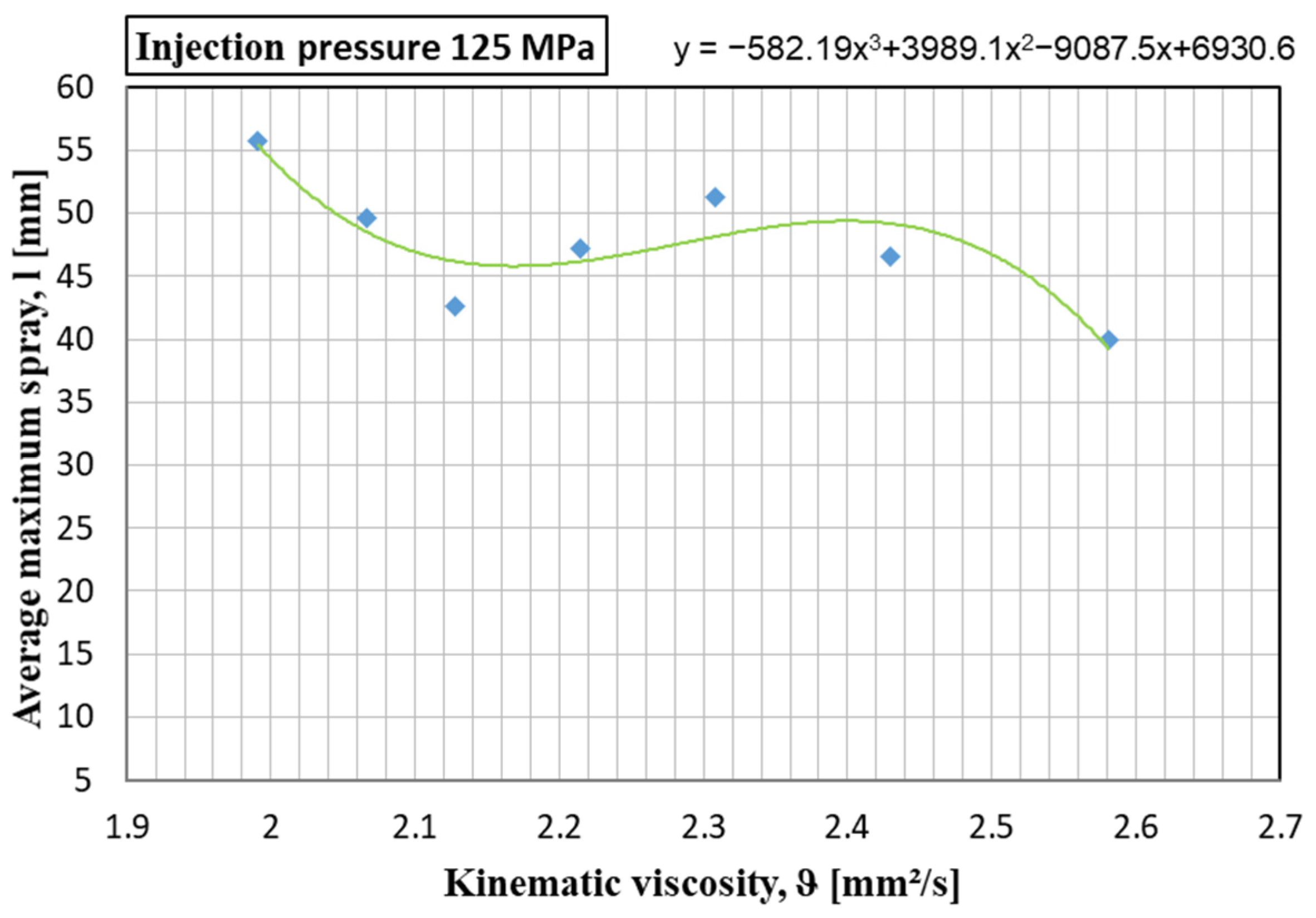Effect of Ethanol Added to Diesel Fuel on the Range of Fuel Spray
Abstract
:1. Introduction
- Optimisation of the combustion chamber and appropriate selection of fuel injection parameters;
- Development of alternative fuels;
- Use of nanoadditives in fuels;
- Exhaust gas aftertreatment systems.
- Breaking up the fuel dose into a large number of droplets, thereby increasing the surface area of the fuel dose to accelerate evaporation and mixing with the air, i.e., ensuring the proper microstructure of the mixture.
- The uniform distribution of the fuel in the combustion chamber, as required by its dimensions, i.e., ensuring the proper macrostructure of the mixture.
- An assessment of the kinematic viscosity of conventional diesel fuel and ethanol–diesel fuel blends;
- Visualisation tests focusing on the injection process for the fuels investigated, carried out at a workstation; these aimed to determine the geometry of the fuel spray (maximum range of spray tip),
- An assessment of the relationship between the injection parameters and the parameters of the spray macrostructure.
2. Research Method
- Temperature range: −40 ÷ +100 °C;
- Testing range, depending on the capillary used: 1 ÷ 50,000 mm2/s;
- External thermostatic system with temperature control range: from −80 to +20 °C;
- Accuracy of temperature stability: ±0.01 °C.
- Test bench for testing injector systems;
- A separate hydraulic system feeding the injection system;
- A visualisation chamber with a constant volume;
- The injection system (high-pressure pump, fuel tank, and common rail electromagnetic injector with needle lift sensor);
- A thermographic camera to measure the temperature of the injector (Figure 2);
- A high-speed camera for filming the evolution of spray in the visualisation chamber.
- Duration of the entire signal controlling the opening of the injector;
- Duration of the sustain signal;
- Frequency of the sustain signal;
- Fullness of the sustain signal.
- Cleaning the hydraulic system with compressed air and filling the system with the investigated fuel;
- Setting the appropriate injection pressure and time;
- Performing a procedure of heating the fuel in the system to a temperature of 40 °C ± 2 °C and the injector to a temperature of 55 °C ± 2 °C (the required temperatures are obtained through the operation of the system under the specified test conditions);
- Performing a single injection into the visualisation chamber and recording it with a high-speed camera;
- Repeating the measurements a defined number of times to obtain results for statistical processing;
- Repeating the measurements for all the defined values of pressure in the system;
- After the tests have been completed, removing the fuel and flushing the system.
3. Results and Analysis
4. Conclusions
Author Contributions
Funding
Institutional Review Board Statement
Informed Consent Statement
Data Availability Statement
Acknowledgments
Conflicts of Interest
Abbreviations
| CO | Carbon monoxide |
| CO2 | Carbon dioxide |
| HC | Hydrocarbons |
| NOx | Nitrogen oxides |
| PM | Particulate matter |
References
- Cardone, M.; Marialto, R.; Ianniello, R.; Lazzaro, M.; Di Blasio, G. Spray Analysis and Combustion Assessment of Diesel-LPG Fuel Blends in Compression Ignition Engine. Fuels 2021, 2, 1–15. [Google Scholar] [CrossRef]
- Glensor, K.; Muñoz, B.M.R. Life-Cycle Assessment of Brazilian Transport Biofuel and Electrification Pathways. Sustainability 2019, 11, 6332. [Google Scholar] [CrossRef]
- Imran, S.; Emberson, D.; Hussain, A.; Ali, H.; Ihracska, B.; Korakianitis, T. Performance and specific emissions contours throughout the operating range of hydrogen-fueled compression ignition engine with diesel and RME pilot fuels. Alex. Eng. J. 2015, 54, 303–314. [Google Scholar] [CrossRef]
- Channappagoudra, M.; Ramesh, K.; Manavendra, G. Comparative study of standard engine and modified engine with different piston bowl geometries operated with B20 fuel blend. Renew. Energy 2019, 133, 216–232. [Google Scholar] [CrossRef]
- Loganathan, S.; Martin, M.L.J.; Nagalingam, B.; Prabhu, L. Heat release rate and performance simulation of DME fuelled diesel engine using oxygenate correction factor and load correction factor in double Wiebe function. Energy 2018, 150, 77–91. [Google Scholar] [CrossRef]
- Yesilyurt, M.K. The effects of the fuel injection pressure on the performance and emission characteristics of a diesel engine fuelled with waste cooking oil biodiesel-diesel blends. Renew. Energy 2019, 132, 649–666. [Google Scholar] [CrossRef]
- Karwade, A.; Thombre, S.; Bhiogade, G. Investigations on premixed charge compression ignition type combustion using butanol-diesel blends. J. Therm. Sci. Technol. 2020, 15, JTST0026. [Google Scholar] [CrossRef]
- Sitnik, L.J.; Sroka, Z.J.; Andrych-Zalewska, M. The Impact on Emissions When an Engine Is Run on Fuel with a High Heavy Alcohol Content. Energies 2021, 14, 41. [Google Scholar] [CrossRef]
- Brandão, L.F.P.; Suarez, P.A.Z. Study of Kinematic Viscosity, Volatility and Ignition Quality Properties of Butanol/Diesel Blends. Braz. J. Chem. Eng. 2018, 35, 1405–1414. [Google Scholar] [CrossRef]
- Nithyanandan, K.; Zhang, J.; Li, Y.; Wu, H.; Lee, T.H.; Lin, Y.; Lee, C.-F.F. Improved SI engine efficiency using Acetone–Butanol–Ethanol (ABE). Fuel 2019, 174, 333–343. [Google Scholar] [CrossRef] [Green Version]
- Prasad, K.S.; Rao, S.S.; Raju, V. Effect of compression ratio and fuel injection pressure on the characteristics of a CI engine operating with butanol/diesel blends. Alex. Eng. J. 2021, 60, 1183–1197. [Google Scholar] [CrossRef]
- Kuszewski, H. ‘Experimental investigation of the effect of ambient gas temperature on the autoignition properties of ethanol–diesel fuel blends’. Fuel 2018, 214, 26–38. [Google Scholar] [CrossRef]
- Lapuerta, M.; Ramos, Á.; Barba, J.; Fernández-Rodríguez, D. Cold- and warm-temperature emissions assessment of n-butanol blends in a Euro 6 vehicle. Appl. Energy 2018, 218, 173–183. [Google Scholar] [CrossRef]
- Taghizadeh-Alisaraei, A.; Rezaei-Asl, A. The effect of added ethanol to diesel fuel on performance, vibration, combustion and knocking of a CI engine. Fuel 2016, 185, 718–733. [Google Scholar] [CrossRef]
- Kuszewski, H.; Krzemiński, A.; Ustrzycki, A. Wpływ zawodnienia alkoholu na pochodną liczbę cetanową mieszaniny oleju napędowego z etanolem oraz dodatkiem dodekanolu. In Monografia Systemy i Środki Transportu Samochodowego; Oficyna wydawnicza Politechniki Rzeszowskiej: Rzeszów, Poland, 2017. [Google Scholar]
- Baczewski, K.; Kałdoński, T. Paliwa do Silników o Zapłonie Samoczynnym; WKŁ: Warszawa, Poland, 2008; ISBN 978-83-206-1705-4. [Google Scholar]
- Laza, T.; Bereczky, A. Basic fuel properties of rapeseed oil-higher alcohols blends. Fuel 2011, 90, 803–810. [Google Scholar] [CrossRef]
- Hansen, A.C.; Zhang, Q.; Lyne, P.W. Ethanol–diesel fuel blends—A review. Bioresour. Technol. 2005, 96, 277–285. [Google Scholar] [CrossRef] [PubMed]
- Lapuerta, M.; Armas, O.; Herreros, J.M. Emissions from a diesel–bioethanol blend in an automotive diesel engine. Fuel 2008, 87, 25–31. [Google Scholar] [CrossRef]
- Kuszewski, H.; Jaworski, A.; Ustrzycki, A. Lubricity of ethanol–diesel blends—Study with the HFRR method. Fuel 2017, 208, 491–498. [Google Scholar] [CrossRef]
- Li, D.-G.; Zhen, H.; Xingcai, L.; Wu-Gao, Z.; Jian-Guang, Y. Physico-chemical properties of ethanol–diesel blend fuel and its effect on performance and emissions of diesel engines. Renew. Energy 2005, 30, 967–976. [Google Scholar] [CrossRef]
- Tutak, W.; Lukács, K.; Szwaja, S.; Bereczky, A. Alcohol–diesel fuel combustion in the compression ignition engine. Fuel 2015, 154, 196–206. [Google Scholar] [CrossRef]
- Torres-Jimenez, E.; Jerman, M.S.; Gregorc, A.; Lisec, I.; Dorado, M.P.; Kegl, B. Physical and chemical properties of ethanol–diesel fuel blends. Fuel 2011, 90, 795–802. [Google Scholar] [CrossRef]
- Gnanamoorthi, V.; Devaradjane, G. Effect of compression ratio on the performance, combustion and emission of DI diesel engine fueled with ethanol–Diesel blend. J. Energy Inst. 2015, 88, 19–26. [Google Scholar] [CrossRef]
- Kuszewski, H.; Jaworski, A.; Ustrzycki, A.; Lejda, K.; Balawender, K.; Woś, P. Use of the constant volume combustion chamber to examine the properties of autoignition and derived cetane number of mixtures of diesel fuel and ethanol. Fuel 2017, 200, 564–575. [Google Scholar] [CrossRef]
- Murcak, A.; Haşimoğlu, C.; Çevik, I.; Kahraman, H. Effect of injection timing to performance of a diesel engine fuelled with different diesel–ethanol mixtures. Fuel 2015, 153, 569–577. [Google Scholar] [CrossRef]
- Yilmaz, N.; Ileri, E.; Atmanlı, A.; Karaoglan, A.D.; Okkan, U.; Kocak, M.S. Predicting the Engine Performance and Exhaust Emissions of a Diesel Engine Fueled with Hazelnut Oil Methyl Ester: The Performance Comparison of Response Surface Methodology and LSSVM. J. Energy Resour. Technol. 2016, 138, 052206. [Google Scholar] [CrossRef]
- Zabaniotou, A.; Ioannidou, O.; Skoulou, V. Rapeseed residues utilization for energy and 2nd generation biofuels. Fuel 2008, 87, 1492–1502. [Google Scholar] [CrossRef]
- Zhu, L.; Cheung, C.; Zhang, W.; Huang, Z. Emissions characteristics of a diesel engine operating on biodiesel and biodiesel blended with ethanol and methanol. Sci. Total. Environ. 2010, 408, 914–921. [Google Scholar] [CrossRef]
- Gao, Z.; Lin, S.; Ji, J.; Li, M. An experimental study on combustion performance and flame spread characteristics over liquid diesel and ethanol-diesel blended fuel. Energy 2019, 170, 349–355. [Google Scholar] [CrossRef]
- Hulwan, D.B.; Joshi, S.V. Performance, emission and combustion characteristic of a multicylinder DI diesel engine running on diesel–ethanol–biodiesel blends of high ethanol content. Appl. Energy 2011, 88, 5042–5055. [Google Scholar] [CrossRef]
- Park, S.H.; Youn, I.M.; Lee, C.S. Influence of ethanol blends on the combustion performance and exhaust emission characteristics of a four-cylinder diesel engine at various engine loads and injection timings. Fuel 2011, 90, 748–755. [Google Scholar] [CrossRef]
- Lotko, W. Self-Ignition Delay and Control Parameters of Diesel Engines for Different Vehicle Feeding Systems and Different Fuels. Adv. Sci. Technol. Res. J. 2021, 15, 245–254. [Google Scholar] [CrossRef]
- Kostas, J.; Honnery, D.; Soria, J. Time resolved measurements of the initial stages of fuel spray penetration. Fuel 2009, 88, 2225–2237. [Google Scholar] [CrossRef]
- Shao, J.; Yan, Y. Digital Imaging Based Measurement of Diesel Spray Characteristics. IEEE Trans. Instrum. Meas. Technol. Conf. Proc. 2008, 57, 9. [Google Scholar]
- Kuszewski, H.; Lejda, K.; Szlachta, Z. The analysis of spray parameters of fuels of different viscosity sprayed by a typical and rotary-swinging needle injectors. Combust. Engines 2004, 119, 23–31. [Google Scholar] [CrossRef]
- Ochęduszko, S. Termodynamika Stosowana; WNT: Warsaw, Poland, 1974. [Google Scholar]
- Atmanli, A.; Ileri, E.; Yuksel, B.; Yilmaz, N. Extensive analyses of diesel–vegetable oil– n -butanol ternary blends in a diesel engine. Appl. Energy 2015, 145, 155–162. [Google Scholar] [CrossRef]
- Desantes, J.; Payri, R.; Salvador, F.; Gil, A. Development and validation of a theoretical model for diesel spray penetration. Fuel 2006, 85, 910–917. [Google Scholar] [CrossRef]
- Brzeżański, M. Carbon dioxide emissions in the aspect of applied engine fuels. Combust. Engines 2007, 131, 62–67. [Google Scholar] [CrossRef]
- Pielecha, I.; Czajka, J.; BOROWSKI, P.; Wisłocki, K. Research-based assessment of the influence of hydrocarbon fuel atomization on the formation of self-ignition spots and the course of pre-flame processes. Combust. Engines 2014, 157, 22–35. [Google Scholar] [CrossRef]
- Pischinger, R.; Klell, M.; Sams, T. Thermodynamik der Verbrennungskraftmaschine; Springer: Berlin/Heidelberg, Germany, 2009. [Google Scholar] [CrossRef]
- Wisłocki, K. Studium Wykorzystania Badań Optycznych do Analizy Procesów Wtrysku i Spalania w Silnikach o Zapłonie Samoczynnym. Ph.D. Thesis, Wydawnictwo Politechniki Poznańskiej, Poznań, Poland, 2004. Rozprawa nr 387. [Google Scholar]
- Yanowitz, J.; Ratcliff, M.A.; McCormick, R.L.; Taylor, J.D.; Murphy, M.J. Compendium of Experimental Cetane Numbers; Tech-nical Report NREL/TP-5400-61693; National Renewable Energy Laboratory: Denver, CO, USA, 2014. [Google Scholar]
- Al-Esawi, N.; Al Qubeissi, M.; Kolodnytska, R. The Impact of Biodiesel Fuel and Ethanol/Diesel Blends. Energies 2019, 12, 1804. [Google Scholar] [CrossRef]
- Razzaq, L.; Farooq, M.; Mujtaba, M.; Sher, F.; Farhan, M.; Hassan, M.; Soudagar, M.; Atabani, A.; Kalam, M.; Imran, M. Modeling Viscosity and Density of Ethanol-Diesel-Biodiesel Ternary Blends for Sustainable Environment. Sustainability 2020, 12, 5186. [Google Scholar] [CrossRef]
- Kumar, B.R.; Saravanan, S. Use of higher alcohol biofuels in diesel engines: A review. Renew. Sustain. Energy Rev. 2016, 60, 84–115. [Google Scholar] [CrossRef]
- Kwanchareon, P.; Luengnaruemitchai, A.; Jai-In, S. Solubility of a diesel–biodiesel–ethanol blend, its fuel properties, and its emission characteristics from diesel engine. Fuel 2007, 86, 1053–1061. [Google Scholar] [CrossRef]
- Instrukcja Obsługi Aparatu HVU 482; Inkom Instruments: Warszawa, Poland, 2011.
- Krzemiński, A.; Lejda, K.; Ustrzycki, A. Influence of dodecanol addition on the energy value of diesel oil mixture with ethanol. Висник Нацioнальнoгo Транспoртнoгo Унiверситетую 2019, 3, 67–73. [Google Scholar]
- Karta Charakterystyki: Alkohol Etylowy Całkowicie Skażony; Alpinus: Miszewko, Poland, 2016.
- Karta Charakterystyki: 1-Dodekanol ≥98% do Syntezy; Carl Roth GmbH + Co KG: Karlsruhe, Germany, 2016.
- Kuszewski, H.; Krzemiński, A.; Ustrzycki, A. Metodyka Badań Wizyjnych Rozwoju Strugi Paliwa Generowanej Przez Wysokociśnieniowy Układ Wtryskowy; Oficyna wydawnicza Politechniki Rzeszowskiej: Rzeszów, Poland, 2020. [Google Scholar]
- Zięba, A. Pracownia Fizyczna Wydziału Fizyki i Techniki Jądrowej; AGH: Kraków, Poland, 2002. [Google Scholar]
- Przewodnik Głównego Urzędu Miar: Wyrażanie Niepewności Pomiaru; Główny Urząd Miar: Warszawa, Poland, 1999.
- Payri, F.; Payri, R.; Salvador, F.J.; Martínez-López, J. A contribution to the understanding of cavitation effects in Diesel injector nozzles through a combined experimental and computational investigation. Comput. Fluids 2012, 58, 88–101. [Google Scholar] [CrossRef]
- Wang, C.; Li, G.-X.; Sun, Z.-Y.; Wang, L.; Sun, S.-P.; Gu, J.-J.; Wu, X.-J. Effects of structure parameters on flow and cavitation characteristics within control valve of fuel injector for modern diesel engine. Energy Convers. Manag. 2016, 124, 104–115. [Google Scholar] [CrossRef]











| No | Type of Fuel | Percentage [% v/v] | ||
|---|---|---|---|---|
| Diesel Oil | Ethanol | Dodecanol | ||
| 1 | ON | 100 | 0 | 0 |
| 2 | ON + ET5 | 95 | 5 | 5 |
| 3 | ON + ET10 | 90 | 10 | 5 |
| 4 | ON + ET15 | 85 | 15 | 5 |
| 5 | ON + ET20 | 80 | 20 | 5 |
| 6 | ON + ET25 | 75 | 25 | 5 |
| 7 | ON + ET30 | 65 | 30 | 5 |
| Name of Parameter | Unit | Value |
|---|---|---|
| Alcohol content at 20 °C | % | 99.9 |
| Density | g/cm3 | 0.7897 |
| Autoignition point | °C | 425 |
| Water content | %(m/m) | ≤0.1 |
| Ester content | mg/100 cm3 | <0.2 |
| Methanol | mg/100 cm3 | <0.6 |
| Name of Parameter | Unit | Value |
|---|---|---|
| Density at 16 °C | g/cm3 | 0.9 |
| Autoignition point | °C | 275 |
| Solubility in water at 25 °C | g/L | 0.037 |
| Melting/solidification point at 101.3 kPa | °C | 24 |
| Flash point at 101.3 kPa | °C | 134.8 |
Disclaimer/Publisher’s Note: The statements, opinions and data contained in all publications are solely those of the individual author(s) and contributor(s) and not of MDPI and/or the editor(s). MDPI and/or the editor(s) disclaim responsibility for any injury to people or property resulting from any ideas, methods, instructions or products referred to in the content. |
© 2023 by the authors. Licensee MDPI, Basel, Switzerland. This article is an open access article distributed under the terms and conditions of the Creative Commons Attribution (CC BY) license (https://creativecommons.org/licenses/by/4.0/).
Share and Cite
Krzemiński, A.; Ustrzycki, A. Effect of Ethanol Added to Diesel Fuel on the Range of Fuel Spray. Energies 2023, 16, 1768. https://doi.org/10.3390/en16041768
Krzemiński A, Ustrzycki A. Effect of Ethanol Added to Diesel Fuel on the Range of Fuel Spray. Energies. 2023; 16(4):1768. https://doi.org/10.3390/en16041768
Chicago/Turabian StyleKrzemiński, Artur, and Adam Ustrzycki. 2023. "Effect of Ethanol Added to Diesel Fuel on the Range of Fuel Spray" Energies 16, no. 4: 1768. https://doi.org/10.3390/en16041768
APA StyleKrzemiński, A., & Ustrzycki, A. (2023). Effect of Ethanol Added to Diesel Fuel on the Range of Fuel Spray. Energies, 16(4), 1768. https://doi.org/10.3390/en16041768






